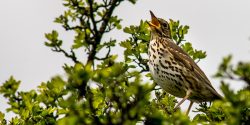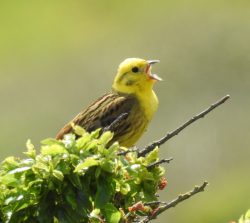 THE National Trust is restoring areas of wood pasture on Purbeck, as part of a project to amplify nature’s chorus. Wood pasture is a prime habitat for our much-loved songbirds, like this beautiful thrush.
THE National Trust is restoring areas of wood pasture on Purbeck, as part of a project to amplify nature’s chorus. Wood pasture is a prime habitat for our much-loved songbirds, like this beautiful thrush.
One of the UK’s most biodiverse habitats, wood pasture is a mosaic of grassland, scrub, hedges and trees. It provides important nesting, roosting and foraging sites for a wide variety of wildlife, including birds such as the yellowhammer, linnet and goldfinch, as well as the extremely rare turtle dove and nightingale.
The aim is to create 380ha (940 acres) of wood pasture, planting around 60,000 trees and shrubs over the next six years. To maximise on blossom and fruit, the trees planted will be native species such as crab apple, hazel, holly, hawthorn, elder and wild pear.
Ben Cooke, Area Ranger for the National Trust, says: “We haven’t yet lost this soundscape in Purbeck, but it has quietened over the last 70 years, with some birds disappearing altogether. By restoring wood pasture, we want to reverse this trend and bring back a cacophony of birdsong and the hum of insects, not just in a few places, but across Purbeck. Imagine how fantastic it would be if the calls of lost species such as the turtle dove became part of our lives again.”
Wood pasture, typified by the landscapes of the New Forest, benefits wildlife because of the mix of habitats. The open ground and grassland encourage an abundance of wildflowers and insects. Scrub islands provide shelter and food for birds, insects and small mammals, while trees are especially attractive to bats, birds and lichens.
 Currently, four tenant farmers in Purbeck are taking part in the wood pasture project, and others are expected to join. With the help of local schools and other community groups, seeds and berries are being harvested from hedgerows and woods. These are being planted in small plots of land which have been rotavated to create bare ground where the seedlings can grow.
Currently, four tenant farmers in Purbeck are taking part in the wood pasture project, and others are expected to join. With the help of local schools and other community groups, seeds and berries are being harvested from hedgerows and woods. These are being planted in small plots of land which have been rotavated to create bare ground where the seedlings can grow.
Ben said: “This looks drastic at first, but the new vegetation will soon take hold, whether it’s been planted or regenerated naturally. We are also experimenting with ways to protect saplings from grazing animals, especially deer, which not only eat the new growth but can jump high fences to get to it.”
In some areas, this involves using protective layers of thorny gorse, bramble and hawthorn, or piles of dead branches. In others, deer-proof exclosures have been erected.
If anyone is interested in helping with wildlife monitoring, seed gathering or planting events across Purbeck, please email
purbeck@nullnationaltrust.org.uk.
© National Trust; photograph of thrush by John Malley; yellowhammer by Pete Christie.